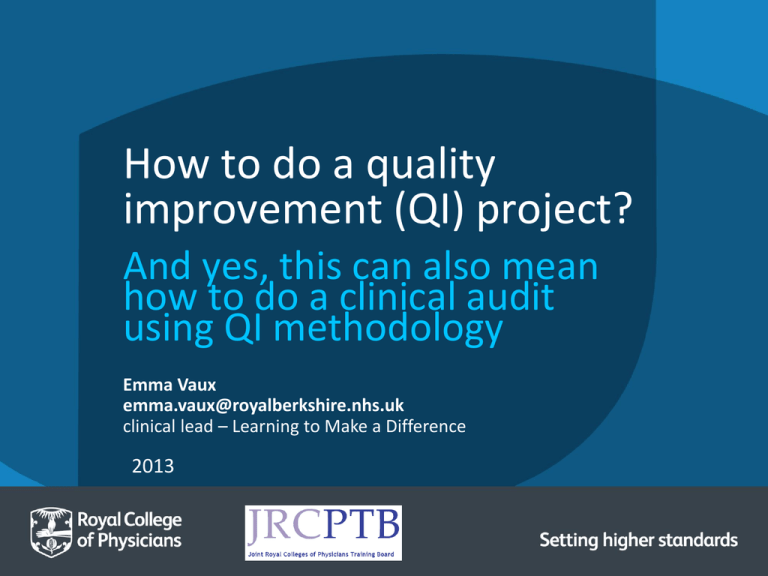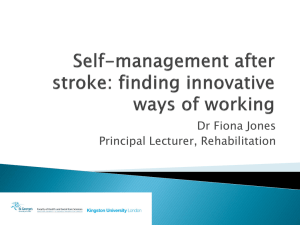How to do a QI Project
advertisement

How to do a quality improvement (QI) project? And yes, this can also mean how to do a clinical audit using QI methodology Emma Vaux emma.vaux@royalberkshire.nhs.uk clinical lead – Learning to Make a Difference 2013 A Model for Learning and Change When you combine the 3 questions with the… PDSA cycle, you get… …the Model for Improvement. The Improvement Guide, API, 1996 2 Repeated Use of the PDSA Cycle Changes That Result in Improvement Model for Improvement What are we trying to accomplish? How will we know that a change is an improvement? A P S D What change can we make that will result in improvement? Spread Implementation of Change Hunches Theories Ideas A P S D Very Small Scale Testcale Test Wide-Scale Tests of Change Follow-up Tests Sequential building of knowledge under a wide range of conditions A QI project in a nutshell Identify a clear and focused SMART aim Decide what change(s) you are going to make Decide what you are going to measure before you start to monitor the impact of any change The overview… It is all about following a structured process Guides to how to make this happen For the trainee For the supervisor All accessed via the LTMD website http://www.rcplondon.ac.uk/projects/lear ning-make-difference-ltmd Top tips Develop your project plan and discuss with your supervisor Involve the right stakeholders It is even better when there is multiprofessional involvement Think of what might be the unintended consequences of any change Prepare to educate others in the MDT about using a QI approach to a problem An example of a QI project Aim To reduce the number of inappropriate urinary catheters inserted into patients admitted to the Clinical Decision Unit by 50% by January 2011 Change Introduce a checklist to be completed prior to any catheter insertion Measure The number of catheters inserted according to trust guidelines measured on a weekly basis….start with measuring the baseline before any change is made and then measuring little and often after any change Test out the next change and keep measuring…………. It is much better to measure 1 day a week, a 10% sample, on one bay of one ward than try and measure everything all the time 8 Measurement Are you finding this confusing? So what is the difference between doing a quality improvement project or a clinical audit? • Simply, clinical audit is doing a quality improvement (QI) project against an agreed standard or practice. As trainees, the traditional way of doing a clinical audit has been a lengthy process, doing one data set collection, possibly having time to make a change and possibly collecting another data set. A QI project uses QI methodology and a structured framework to enable change to happen in a real-time and dynamic way with little and often measurement. By using QI methodology as part of the clinical audit cycle, clinical audit moves to a robust QI process with the focus on change and making a visible, timely difference to patient care. Data points - why measure little and often? The traditional clinical audit way of doing things!! Use of run charts to track changes The change seems to be associated with an improvement The change is not associated with an improvement; if there had been no baseline measurement before making the change, the change might have been mistakenly interpreted as making a difference The change seems to be associated with an improvement initially but the effect does not appear sustained Perla R. BMJ Qual Saf 2011; 20: 46-51 Remember little and often measurement Example of a Learning to make a difference QI project Anxiety and Depression in Acute Stroke Patients Dr Olivia Walker CMT Royal Berkshire NHS Trust Reasons behind the Project NICE guidelines - Agreed local policies and guidelines for screening patients with stroke within 6 weeks of diagnosis, using a validated tool, to identify mood disturbance. Meets the need identified in addressing mood in acute stroke patients in the biannual RCP National Sentinel Stroke Audit. Research suggests that undiagnosed anxiety and depression can have a negative impact upon rehabilitation. The objective To develop a local protocol that can be used to screen all acute stroke patients for anxiety and depression. Project Aim (1) 100% of stroke patients should have a Depression Scale completed within 5 days of admission and recorded in the notes 100% of patients will have a repeat DEPRESSION SCALE completed in the MDT after 2-3 weeks. Project Aim (2) 100% of patients identified with anxiety and/or depression will be referred to the neuropsychologist. All aims to be completed within 4 month time frame on the ASU So Olivia is doing a clinical audit ie a quality improvement project against an agreed standard In this case against NICE recommendations But by using a SMART aim and prospective and little and often measurement Olivia is using QI methodology to implement and test out her changes Change 1 The identification of an appropriate anxiety and depression tool which can be implemented in the Royal Berkshire Hospital (RBH) acute stroke unit. Discussion with the neuropsychologist identified 2 suitable assessments: oHospital Anxiety and Depression Scale (HADS) oNumeric Graphic Rating Scale (NGRS) What was tested Review of 20 stroke patients notes on the unit, on one particular day, using the pro forma. Assessing each patient using either the HADS or the NGRS in the stroke unit on one particular day. Outcomes 1. Need specific guidelines/flow chart to identify which scale to use. 2. Completing the scales is time consuming, therefore a briefer assessment initially would be useful. 3. Need additional scale for patients with aphasia/dysphasia. 4. Patients with cognitive impairment need assistance with completing a scale. Change 2 1. The identification of additional scales The Signs of Depression Scale – to be completed for each patient within 5 days of admission either by the occupational therapist (OT) or in the twice weekly MDT meeting. HADS – to be used with patients without aphasia. If cognitive impairment the OT will go through each question with the patient. NGRS or the DISCs Scale – for patients who struggle with the HADS. The Stroke Aphasic Depression Questionnaire – for patients with aphasia. 2. The development of a flow chart What was tested The notes of 20 patients on the acute stroke unit were reviewed after the implementation of the flow chart. All stroke patients should have an SDSS documented in the notes by the OTs, within 5 days of admission to the acute stroke unit. Outcomes 1. Poor completion of the SDSS within 5 days 2. Barriers identified following discussion with OTs Not part of their routine assessments and therefore can be forgotten. Having the SDSS printed on white paper doesn’t highlight it resulting in it often being overlooked. Change 3 The SDSS is included in the initial patient assessment by the OTs. The SDSS is printed on yellow paper. Outcome What was tested 2 weeks later the notes of 20 patients on the stroke unit were reviewed following the new changes. 1.Improved completion of the SDSS but not yet 100% achieved. 2.New issue identified Only having an initial SDSS may miss patients who develop anxiety/depression later in their admission. Acute stroke unit mood assessment pathway Does the patient have a language problem? No Yes SALT input required to allow for comprehensive screening to take place SADQ DISCS/ NGRS Score ≥ 9 refer urgently to medical team and neuropsychologist HADS A run chart to demonstrate the change over time since the introduction of the SDSS Modified Flow Chart Introduced SDSS Introduced Flow chart SSDS printed on yellow paper The differences made An MDT approach to tackling anxiety and depression in acute stroke patients The RBH Stroke Unit is now compliant with the NICE Guidelines and the biannual RCP National Sentinel Stroke Audit. The new assessment tool identifies patients who may have previously remained undetected. Olivia’s learning points 1. As a junior doctor you can make a difference to patient care. 2. Change takes time and requires dedicated and enthusiastic colleagues to maintain them. 3. It is important to be able to adapt the project as problems arise and accept that timescales often need to be modified. Getting started! Go to LTMD website for ideas and inspiration and the toolkits Think of your own idea Identify a consultant supervisor Ideally involve the MDT Complete the project plan template You can always run your project plan past LTMD team LTMD@rcplondon.ac.uk Get started! Use the template on the website for your report and presentations










